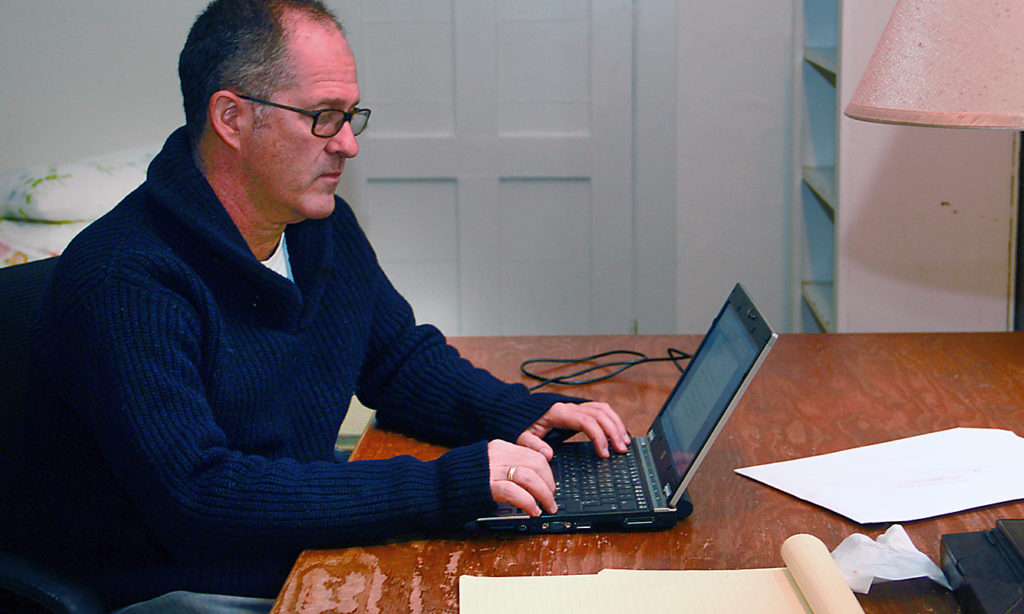Writers Amos Kamil and Zahir Janmohamed were both at work this fall on non-fiction accounts of two very different and personal tragic events.
In June of 2012 when Amos Kamil’s story “Prep-School Predators” appeared as the cover story in The New York Times Magazine, the author knew of three Horace Mann School employees who had sexually abused students at the famed preparatory school. The explosive story of abuse earned Kamil a Pulitzer nomination, but more importantly it was a catalyst for alumni to come forward with their own stories of suffering at the hands of predators and it inspired yet other alumni to offer support and counsel to their abused classmates.
Kamil, who was in residence for three weeks in October, says that eventually, 22 people at Horace Mann were identified as sexual predators. Their lechery extended to male and female students from the late-1960s to the mid-1990s and the story of cover-up and abuse of power just kept growing.
“As the numbers kept expanding and as the school doubled down that it was all in the past,” says Kamil, “I knew there was a bigger story there.... They’ve acted in quite a cowardly way.” As a result, Kamil, also a Horace Mann alum, decided to pursue the story and is turning it into a book, Great is the Truth, not coincidentally the school’s motto.
“The more I knew about the school, the angrier and angrier I became,” Kamil says, explaining that he asked Sean Elder, an editor at Newsweek, to “act as ballast” and help him balance the book’s mix of journalism and personal narrative. “Writing as a reporter, former student, friend [of abused students], and observer ... has been interesting.”
Kamil is using his first MacDowell residency to wrap up Great is the Truth’s final chapters as well as lay out the structure of a dystopian novel, saying his time in Peterborough “has given me the headspace and time to finish up most of this in a good way.”
Ultimately, Great is the Truth is about how institutions should treat adult survivors of such scandal. The school, Kamil says, still hasn’t taken the high road, instead making it look like survivors have come forward for money and not the truth. One of the bright spots in the tale, however, is that in the wake of Kamil’s original magazine story, some 2,500 school alumni have formed the Horace Mann Action Coalition made up of non-abused alumni rallying around their abused classmates on a number of fronts.
“It’s a powerful reminder of the healing nature of story,” says Kamil.
Another story that begs for a healing outcome is that being written by Zahir Janmohamed. During his first residency at MacDowell in October and November, the freelance journalist worked on the difficult narrative of his and others’ experiences during the Gujarat riots of 2002 in western India.
Janmohamed grew up in California, the son of Muslim Indians from Tanzania. At the age of 25, disillusioned by the racism he saw in the U.S. in the aftermath of 9/11, he decided to explore his Indian heritage and had the bad luck of being in the Indian state of Gujarat when three days of horrific violence resulted in the deaths of more than 1,200 people, most of them Muslims.
Janmohamed returned to the U.S. and spent nine years in Washington, D.C. working as the advocacy director at Amnesty International and later as a foreign affairs advisor to Congressman Keith Ellison from Minnesota. But the story that had been gnawing at him for almost a decade brought him back to India in 2011. Working as a freelance journalist, he sought to write the story that inspired his past work in human rights policy, and resulted in his post-traumatic stress disorder.
“I had to learn how to frame the story,” says the writer. “I don’t want to write about who was at fault or what the Prime Minister did in 2002. I want to write about the person who wakes up at night and still has nightmares.”
By taking the long view of the story, Janmohamed, who identifies as a Muslim, Indian, American, and most intensely as a Californian, hopes to paint a bigger picture than one that’s focused on three days of grisly religious extremism. He’s working on a story about identity, trauma, and memory, and says he’s taking the advice of a couple of publishers who have seen early drafts by working on putting more of himself in the narrative. And being in James Baldwin’s studio has been helpful.
“The hardest part, for me, is writing about myself,” says Janmohamed. “When someone like James Baldwin puts into words these complex painful experiences,” he explains, it can be inspiring for others, readers and writers alike.
Having the time at MacDowell has been a key part of the process, giving him the space to step back from the events, transcribe his interviews, and dig into the reasons for his original trip to India. And having the perspectives of fiction writers and other artists has also been helpful in seeing the long view.
“If I wasn’t here, I wouldn’t be able to write this,” says Janmohamed, “I’d be reporting on some event or local political issue instead.” But being able to concentrate on his literary reportage has been enhanced by his current surroundings. “Here everyone is really supportive. Amos, for example, has become a dear friend and in many ways we are both wrestling the same questions about memory and trauma. The solidarity I feel with him and others is really important when you’re writing about these issues.”

